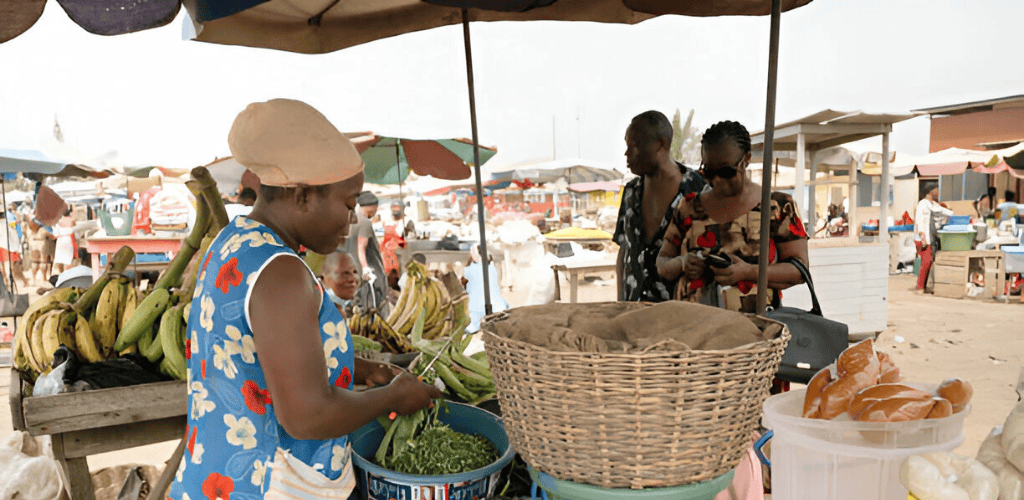Ghana’s employment landscape has significantly changed due to population growth, technological advancements, and government policies designed to improve employment opportunities.
Here’s a detailed insight into Ghana’s current state of work, backed by statistics and facts.
Key takeaways
- Approximately 15.6% of children aged 5 to 17 were engaged in harmful work in 2023.
- Over half of the working population was engaged in vulnerable employment in 2022.
- About 68% of the working-age population was classified as dependent in 2022, primarily due to high unemployment.
- Only about 21% of workers were paid employees in 2023.
- In 2022, there was a significant gender wage gap, with male employees earning GH₵11.0 while females earned GH₵6.9 in the first quarter.
- Nearly 850,000 people moved from employed to unemployed between the first and second quarters of 2022.
- By the third quarter of 2023, more females than males were employed, with females outnumbering males by approximately 900,000 people.
General labour statistics
1. There was an increase in the labour participation rate in Ghana in 2022. (Statista)
Ghana’s labour force participation rate increased to 70.58% in 2022, up from 69.88% in 2021. The labour force participation rate is the share of people aged 15 years and above who are economically active, either employed or actively seeking employment.
2. The labour force participation rate among the male population declined in 2023. (Statista)
The labour force participation rate for males in Ghana was 72.45% in 2023, down from 72.57% in 2022.
3. There was more employment in the service sector than in other sectors in Ghana in 2022. (Statista)
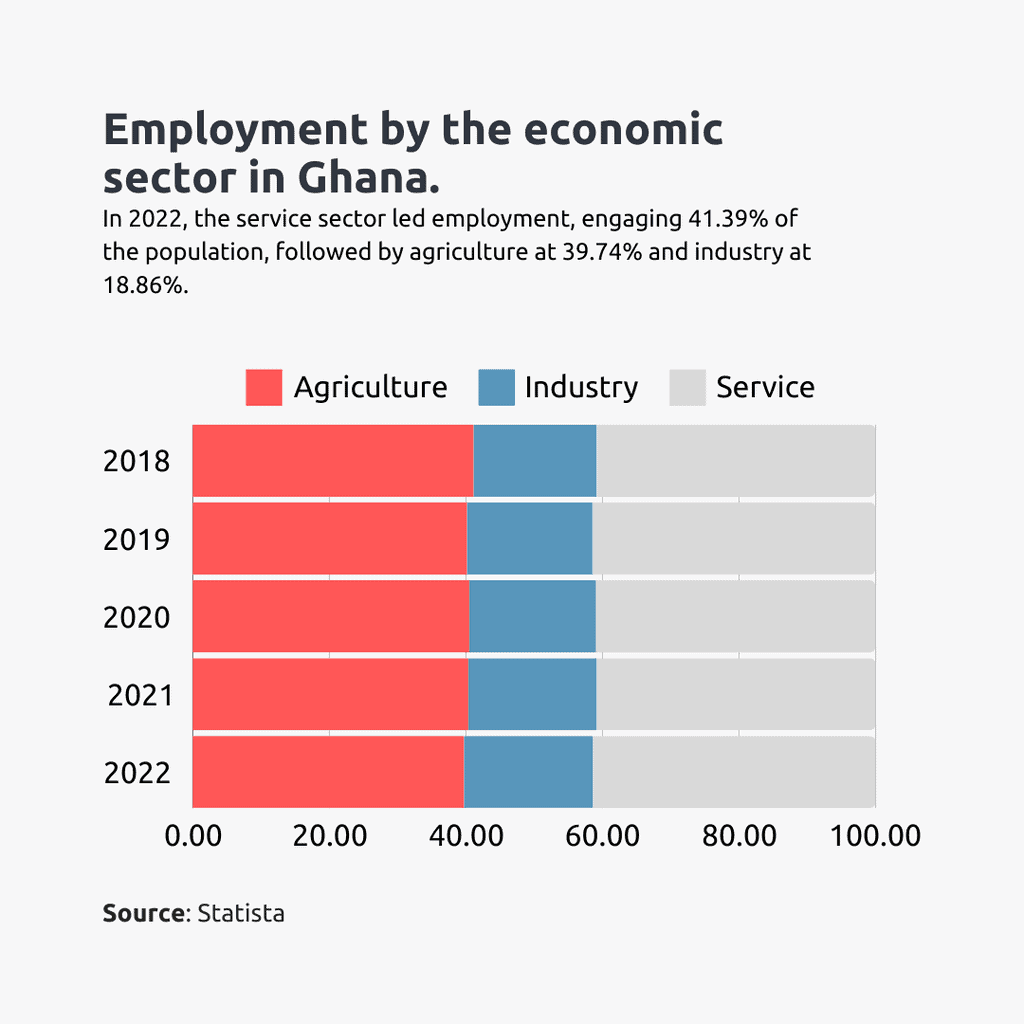
In 2022, the service sector provided more employment than other sectors. The sector employed 41.39% of the total population, the agricultural sector employed 39.74%, and the industry sector employed 18.86%.
4. In 2022, more than half of the working-age people in Ghana were dependent. (Trading Economics)
In 2022, 67.37% of Ghana’s working-age population was classified as dependent, primarily due to the high unemployment rate.
5. The labour force in Ghana was estimated to be approximately 13.99 million people in 2022. (Statista)
Ghana’s labour force was estimated at approximately 13.99 million people in 2022. Over 11.3 million people were aged 25 years and older, while about 2.69 million were between 15 and 24 years old.
| Year | Labor Force (15–24 years) | Labor Force (25 years and older) |
| 2015 | 2,367,000 | 9,857,000 |
| 2016 | 2,395,200 | 10,146,500 |
| 2017 | 2,425,400 | 10,443,400 |
| 2018 | 2,455,700 | 10,736,500 |
| 2019 | 2,488,700 | 11,027,700 |
| 2020 | 2,502,700 | 11,231,900 |
| 2021 | 2,586,500 | 11,553,600 |
| 2022 | 2,665,900 | 11,864,600 |
| 2023 | 2,717,900 | 12,123,800 |
6. The labour participation rate was higher among males than in females in Ghana in 2023. (Statista)
In 2023, the labour force participation rate was higher among males than females. The rate for females was estimated at 65.3%, while for males, it was 72.5%.
7. There was an increase in employment in Ghana in 2023. (Statista)
Employment in Ghana increased in 2023, with about 14.3 million people employed, up from about 14 million in 2022.
8. There are more males in employment than females in Ghana as of 2023. (Statista)
As of 2023, more males were employed than females, with approximately 7.4 million employed males compared to about 6.8 million employed females.
9. The travel and tourism industry contributed 5.7% to total employment in Ghana in 2022. (Statista)
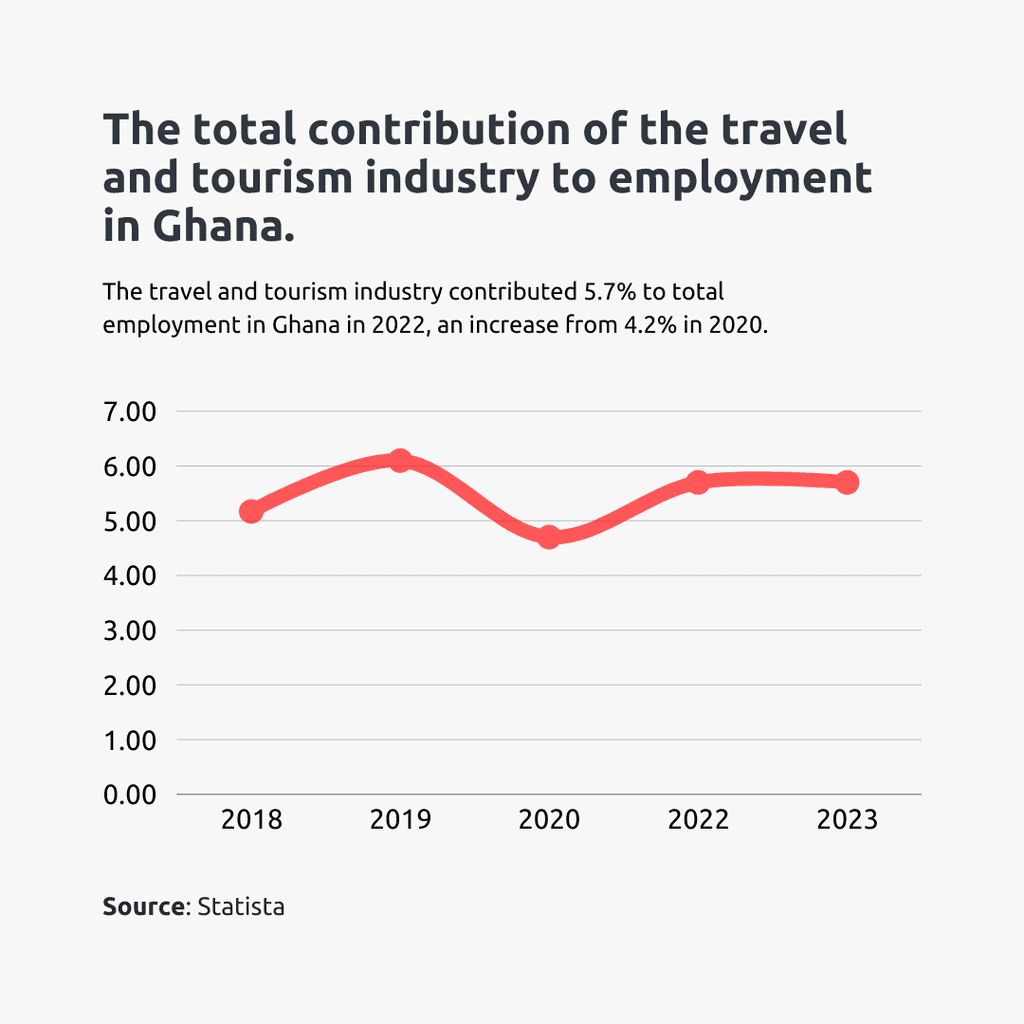
In 2022, the travel and tourism industry contributed 5.7% to total employment in Ghana, an increase from 4.2% in 2020.
10. There was an increase in the total weekly hours worked in Ghana in 2022. (Statista)
In 2022, the total weekly hours worked by the employees increased to about 533 million hours, up from 508 million hours in 2021.
11. 329,000 full-time equivalent jobs were lost in Ghana in 2022 due to the coronavirus (COVID-19) crisis. (Statista)
329,000 full-time equivalent jobs were lost in Ghana in 2022 due to the COVID-19 crisis, calculated based on 40 hours per week of working time.
12. In the second quarter of 2022, there was a decline in Ghana’s economically active people, both employed and unemployed. (AHIES)
The number of economically active people, that is, both employed and unemployed, in Ghana declined from 68.8% in the first quarter to 64.8% in the second quarter of 2022.
13. The peak age at which most people were employed in 2022 was 45 to 49. (AHIES)
In 2022, the age group with the highest employment rate was 45 to 49 years, with 85.4% employed in the first quarter and 83.4% in the second quarter.
14. Less than half of the labour force who hold managerial positions are females in the second quarter of 2022. (AHIES)
In the second quarter of 2022, only 23.8% of the labour force holding managerial positions were females.
15. Ghana’s National Daily Minimum Wage (NDMW) increased by 22% in 2024. (Trading Economics)
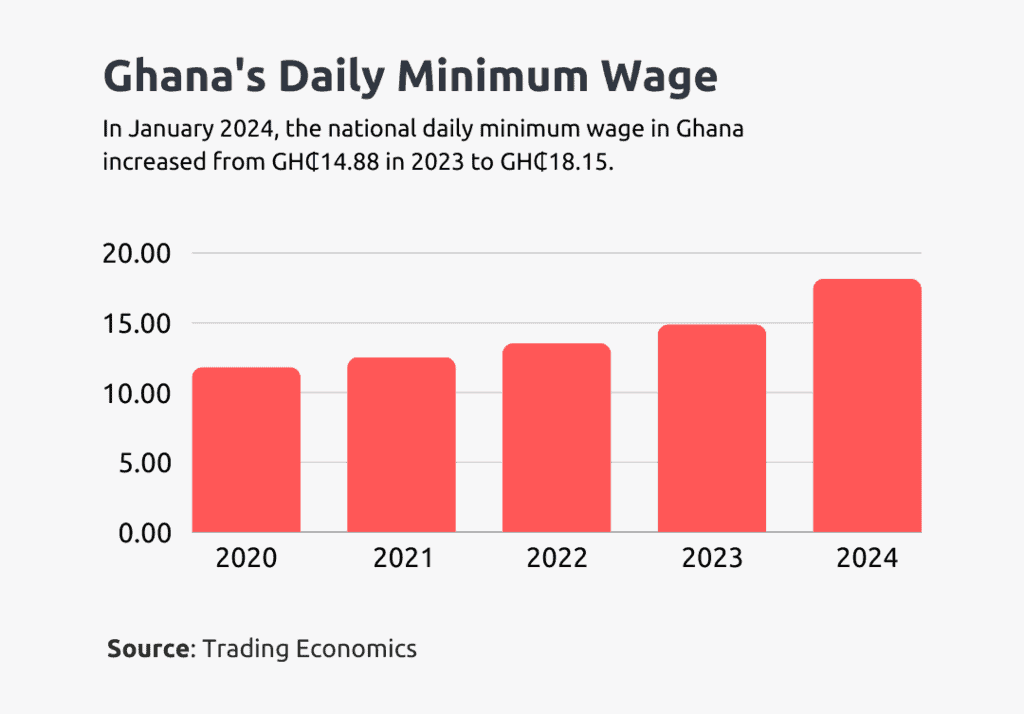
In January 2024, Ghana’s national daily minimum wage increased from GH₵14.88 in 2023 to GH₵18.15.
16. Workers in Executive Management and Change received the highest average salary in Ghana in 2023. (Statista)
In 2023, Executive Management and Change workers received the highest average salary, about 70,000 USD annually. Engineering professionals followed with 52,000 USD annually.
In contrast, operations, purchasing, and logistics workers received the lowest average salary, 6,500 USD annually.
17. The mean hourly earnings for the employees decreased in the second quarter of 2022. (AHIES)
The mean hourly earnings for employees decreased from GH₵9.20 in the first quarter of 2022 to GH₵8.70 in the second quarter.
18. In 2022, the mean hourly earnings of employees were higher in urban areas than rural areas. (AHIES)
In the first and second quarters of 2022, the mean hourly earnings were higher in urban than rural areas.
Urban employees earned GH₵9.6 and GH₵9.1 in the first and second quarters, respectively, while rural employees earned GH₵7.7 and GH₵7.3.
19. In 2022, male employees in Ghana earned a higher average hourly wage than their female counterparts. (AHIES)
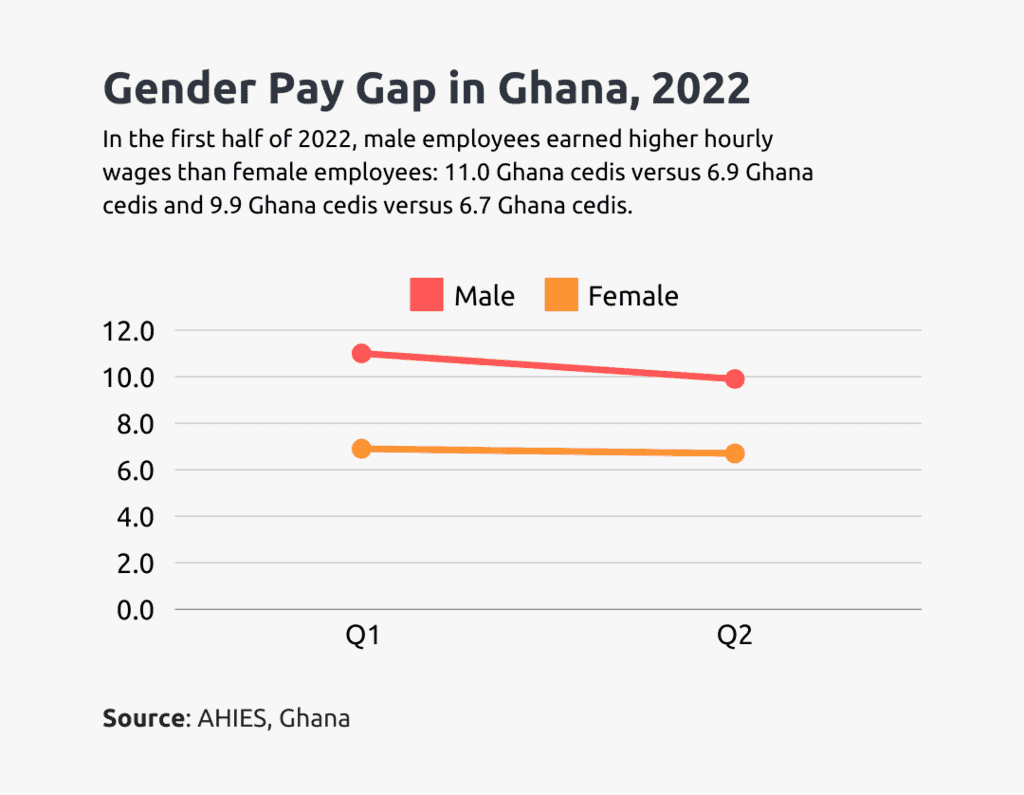
In the first and second quarters of 2022, male employees earned higher mean hourly wages than female employees.
Males earned GH₵11.0 and GH₵9.9 for the first and second quarters, respectively, while female employees earned GH₵6.9 and GH₵6.7.
20. The Greater Accra region of Ghana recorded the highest mean hourly earnings in the first and second quarters of 2022. (AHIES)
The Greater Accra region recorded the highest mean hourly earnings in the first and second quarters of 2022, with GH₵12.0 and GH₵11.0, respectively.
21. Less than a quarter of Ghana’s labour force works with international NGOs or CSOs. (AHIES)
In the first and second quarters of 2022, 0.1% of Ghana’s working population was employed by international NGOs and CSOs.
22. In 2022, more than half of Ghana’s labour force was engaged in vulnerable employment. (AHIES)
Vulnerable employment was more prevalent in rural areas (80.0% in the first quarter and 80.9% in the second quarter) compared to urban areas (56.1% and 56.7%).
23. Females engaged in vulnerable employment than males in 2022. (AHIES)
A higher percentage of the female working population was engaged in vulnerable employment (76.2% in the first quarter and 77.7% in the second quarter) compared to males (54.2% in the first quarter and 56.0% in the second quarter).
24. North East region had the highest percentage of people engaged in vulnerable employment in Ghana. (AHIES)
The North East region had the highest percentage of vulnerable employment in the first and second quarters of 2022, with 88.4% and 89.2% respectively, while the Greater Accra region had the lowest, with 45.6% and 47.6% respectively.
25. Over 500,000 people in Ghana moved from unemployed to employed in 2022. (AHIES)
Between the first and second quarters of 2022, almost 850,000 people went from being employed to being unemployed, and over 500,000 went from being unemployed to being employed.
The table below highlights all the significant changes:
| Q1 Status | Q2 Status | Number of Persons |
| Employed | Unemployed | 850,000 |
| Unemployed | Employed | 500,000+ |
| Employed | Exited Labour Force | 1.4 million |
| Outside Labour Force | Employed | 1.2 million |
| Unemployed | Exited Labour Force | 760,000 |
| Outside Labour Force | Unemployed | 445,000 |
26. More people exited the workforce than were employed in Ghana in 2022. (AHIES)
1.4 million workers left the workforce in the second quarter of 2022, while only 1.2 million unemployed people in the first quarter found employment during the same period.
27. 73,732 people benefited from YEA programs in Ghana in 2022. (MELR)
In 2022, 73,732 individuals benefited from the Youth Employment Agency (YEA) programs, comprising 45,005 females and 28,727 males. This represents a significant increase compared to 22,229 beneficiaries in 2021.
28. Co-operatives also contributed to employment in Ghana in 2022. (MELR)
Co-operatives in Ghana employed 1,726 individuals in 2022.
29. In 2022, the private sector reported the highest workplace accidents. (MELR)
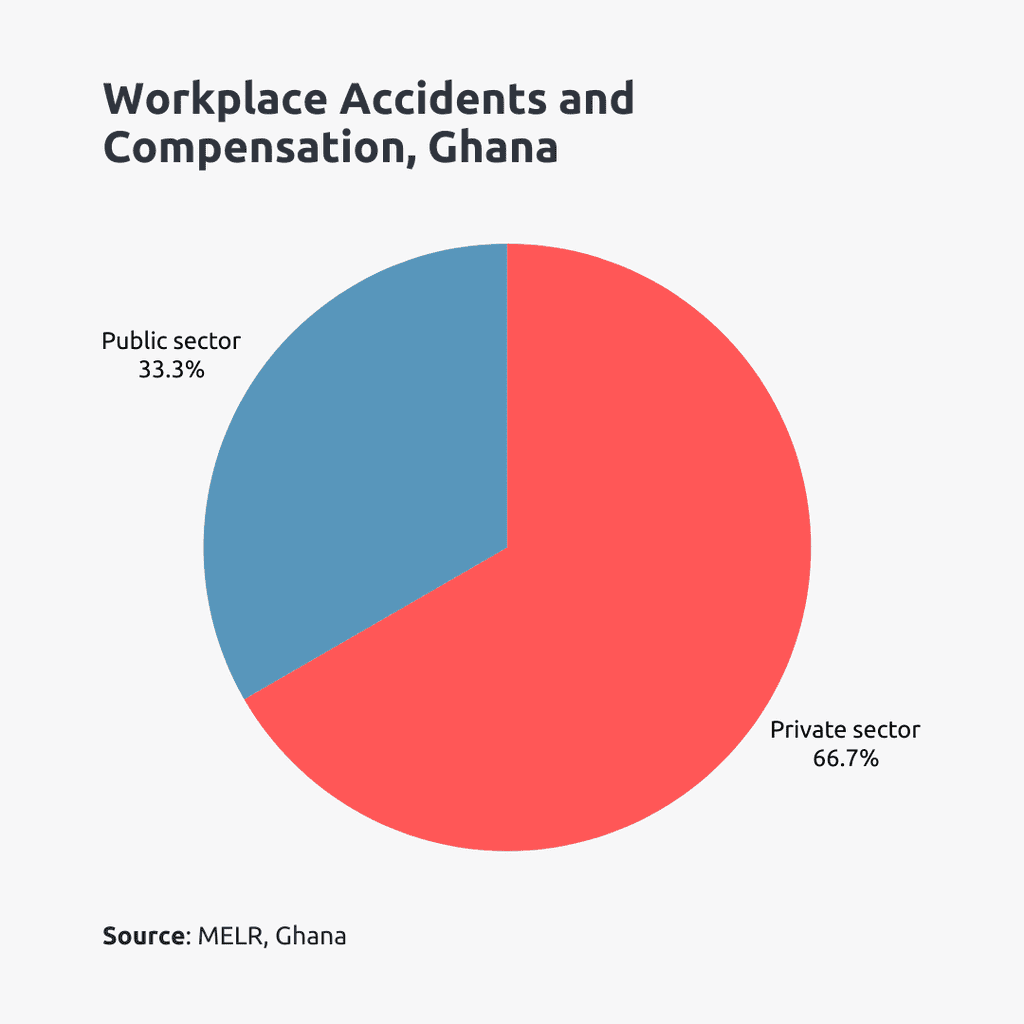
In 2022, the private sector reported 669 workplace accidents, surpassing the 374 cases reported by the public sector.
Consequently, the private sector paid GH₵6,963,551.11 in compensation for 298 cases, while the public sector paid GH₵3,481,775.55 for 223 cases.
30. Greater Accra reported the highest number of workplace accidents and claims in 2022. (MELR)
The Greater Accra region recorded the highest number of work accidents and reported claims in 2022, with 723 cases, while the North East Region recorded no work accidents and reported claims from 2020 to 2022.
31. There were more male registered job seekers than females in Ghana in 2022. (MELR)
In 2022, there were 3,913 registered job seekers, with more males (2,485) than females (1,428). Of these, only 1,679 were successfully employed, while 2,234 remained unemployed.
Bono East Region had the highest number of registered job seekers (946), comprising 522 males and 424 females. In contrast, the Upper West, Savannah, and North East regions did not register any job seekers.
32. There was an increase in employment in the third quarter of 2023. (AHIES)
Employment continued to grow in 2023, with 11.09 million people employed in the first quarter, 11.20 million in the second quarter, and 11.36 million in the third quarter.
By the third quarter of 2023, the number of employed females surpassed that of males, with females outnumbering males by approximately 900,000.
33. More males were in paid employment than females in Q1 2022. (AHIES)
In the first quarter of 2022, approximately 29% of males were employed in paid jobs, compared to less than 15% of females.
The data suggests that females were more likely to be self-employed without employees in non-agricultural activities, while males were more likely to be in paid employment.
Private sector employment
34. Less than a quarter of the labour force in Ghana work in private formal employment. (AHIES)
In 2022, 7.1% of Ghana’s working population in the first quarter and 6.9% in the second quarter were employed in the private formal sector.
In the first quarter, 12.1% of the male working population and 11.7% in the second quarter were employed in private formal employment, compared to 7.2% and 6.8% of females, respectively.
35. Employment in the private formal sector declined slightly in Q2 2022. (AHIES)
The number of people employed in the private formal sector decreased from 798,162 in the first quarter of 2022 to 738,165 in the second quarter.
36. Female and male representation in managerial positions in the formal sector varied by location in Q1 2022. (AHIES)
In the first quarter of 2022, females held 25.1% of managerial positions in urban areas and 15.1% in rural areas, while males held 74.9% and 84.9%, respectively.
Public sector employment
37. Close to a quarter of Ghana’s labour force worked in the public or government sector (AHIES).
The table below presents the percentage of employed persons by sector for Quarter 1 of 2022 based on the available data.
| Sector | Percentage of Total Employed |
| Public (Government) | 21.5% |
| Semi-Public/Parastatal | 3.9% |
| Private Formal | 7.1% |
| Private Informal | 61.4% |
| Local NGO/CSO | 1.7% |
| International NGO/CSO | 0.3% |
| Religious Organisation (Local) | 0.3% |
| Religious Organisation (International) | 0.1% |
| International Organisation | 0.1% |
Informal sector employment
38. More than half of the labour force in Ghana work in private informal employment. (AHIES)
In 2022, most of the labour force worked in private informal employment. In the first quarter, 83.4% were employed in this sector, increasing to 84.1% in the second quarter.
Employment in the private informal sector was more prevalent among females in 2022 (87.4% in the first quarter and 88.0% in the second) than males (79.0% in the first quarter and 79.7% in the second quarter).
Unemployment in Ghana
39. In 2023, there was a decline in the youth unemployment rate in Ghana. (Statista)
In 2023, the youth unemployment rate decreased to around 5.5%, down from 5.93% in 2021.
This rate reflects the percentage of individuals aged 15 to 24 who are unemployed but actively seeking work, excluding those who are not actively looking for employment, such as students.
40. The unemployment rate in Ghana remained the same in 2023. (Statista)
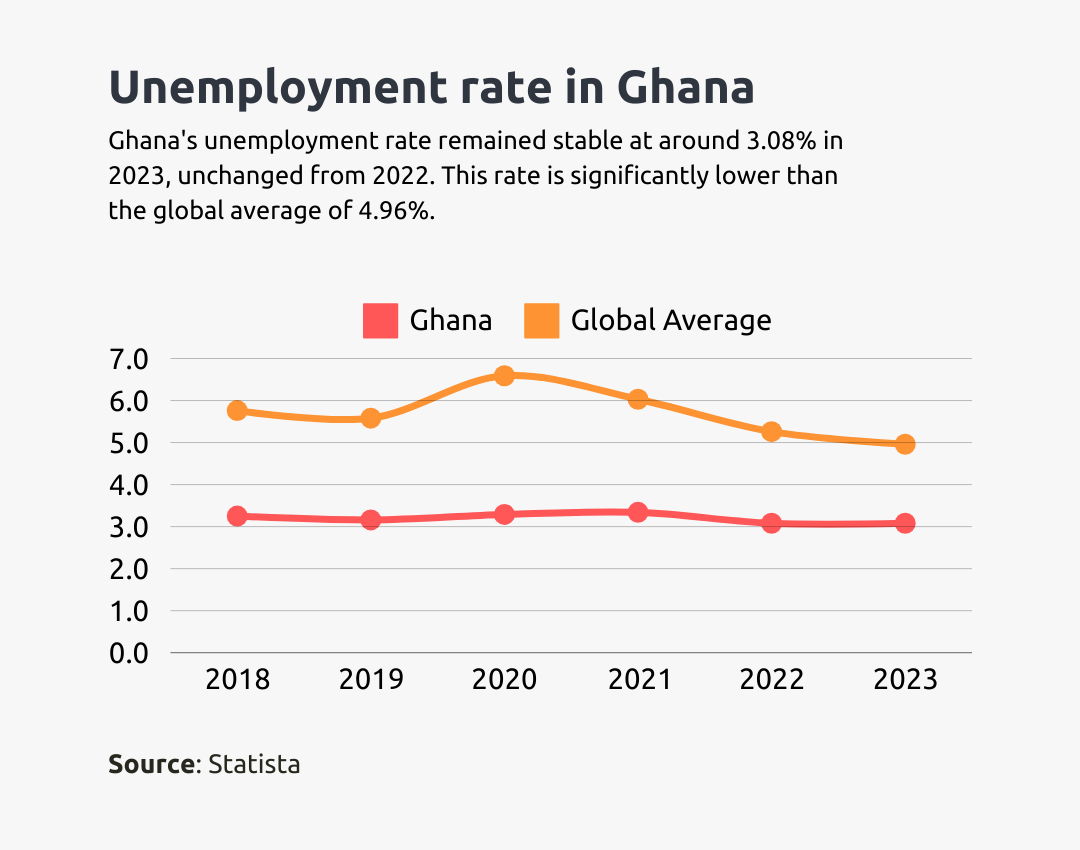
Ghana’s unemployment rate remained steady at approximately 3.08% in 2023, the same as in 2022. This rate is lower than the global average of 4.96%.
41. In 2022, unemployment increased among Ghana’s economically active population. (AHIES)
Unemployment among the economically active population with no formal education increased from 14.7% in the first quarter to 19.0% in the second quarter of 2022.
Conversely, unemployment decreased among those with formal education:
| Level of education | First quarter (%) | Second quarter (%) |
| Basic education | 12.9 | 10.1 |
| Secondary education | 23.7 | 17.5 |
| Tertiary education | 20.5 | 11.7 |
Likewise, male unemployment increased from 10.3% in the first quarter to 12.4% in the second quarter of 2022. In contrast, the female unemployment rate decreased from 15.9% to 15.2% during the same period.
42. There was an increase in unemployment in Ghana in 2023. (AHIES)
Unemployment rose in 2023, from 1.69 million people in the first quarter to 1.85 million in the third quarter.
Child labour statistics
43. The government of Ghana increased the number of labour inspections in 2023 to check and reduce child labour. (DOL)
The government increased labour inspections from 1,108 in 2022 to 1,290 in 2023 to combat child labour.
44. As of 2023, 4.1% of children between the ages of 5 and 14 worked in Ghana. (DOL)
As of 2023, 4.1% of children aged 5 to 14, 335,541 were working. Among those involved in child labour, 4.3% were boys, while 4.0% were girls.
Child labour was also more prevalent in rural areas than in urban areas. In rural areas, 5.9% of children were engaged in child labour, compared to 2.5% in urban areas.
45. More than half of the children engaged in child labour worked in agriculture. (DOL)
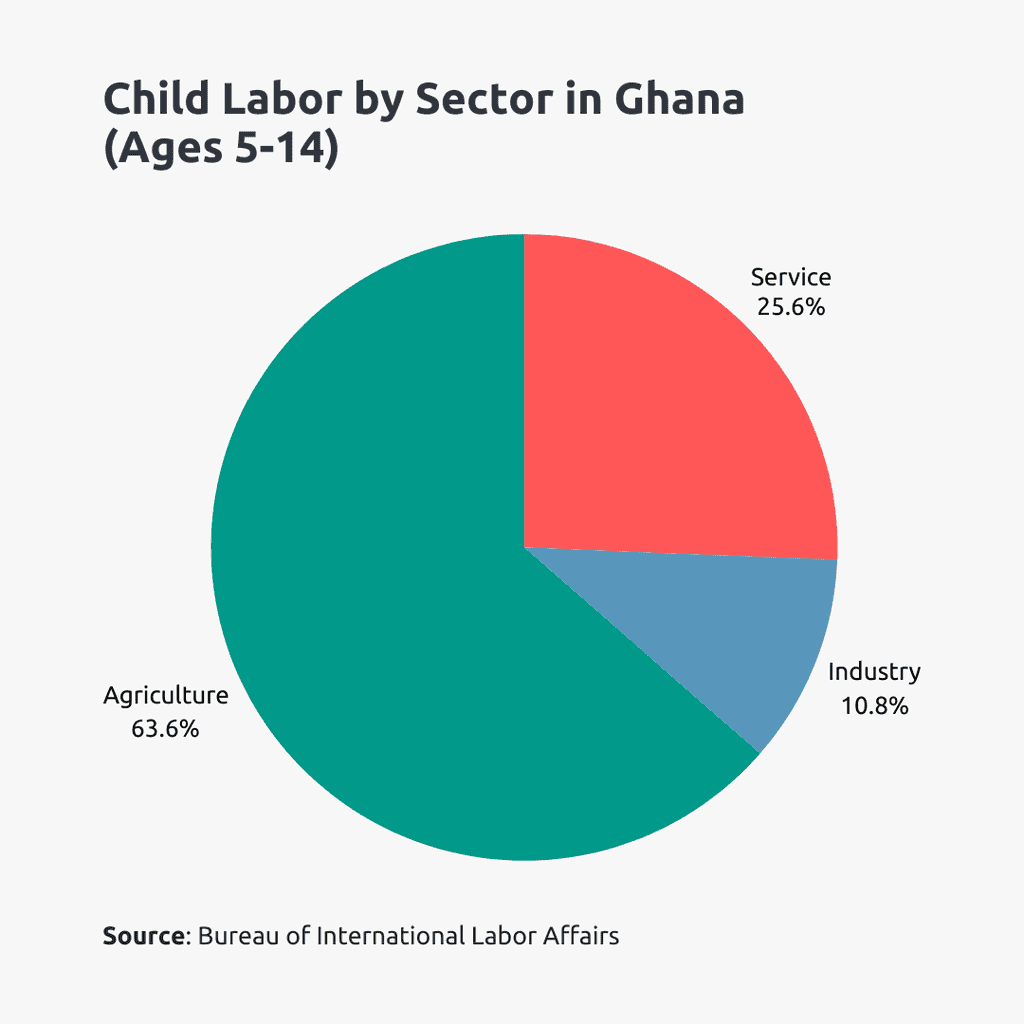
In 2023, it was reported that 63.5% of children aged 5 to 14 engaged in child labour were involved in agriculture, 10.8% in industry, and 25.6 in services.
46. 3.7% of children engaged in child labour combined work with schooling. (DOL)
In 2023, about 3.7% of children in Ghana aged 7 to 14 combined work with attending school.
47. 15.6% of children are engaged in harmful work. (DOL)
Approximately 15.6% of Ghanaian children aged 5 to 17 were engaged in harmful work in 2023.
Causes of child labour in Ghana
Child labour refers to any work done by children who are not yet fit to be economically active, and this work interferes with their education.
- Low-income families often require their children to work to contribute to household income.
- In many rural areas, ignorance about the importance of education and limited access to quality education force children to enter the workforce early.
- In some communities, child labour is recognised as part of the culture, where children work to learn skills or support the family.
- Children are more likely to be forced into labour to fend for themselves in regions affected by war, instability, or natural disasters.
Conclusion
The state of work in Ghana reflects both progress and ongoing challenges.
While employment opportunities have improved overall, a large portion of the workforce remains in the informal sector, often facing issues like job insecurity and low wages.
More effort is needed to ensure equal growth across all sectors of the economy. What do you think about these insights? Please share them with us in the comments section.
